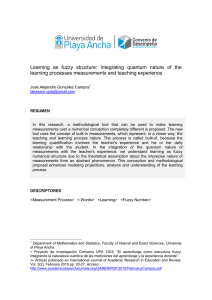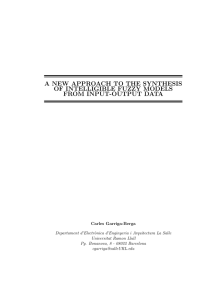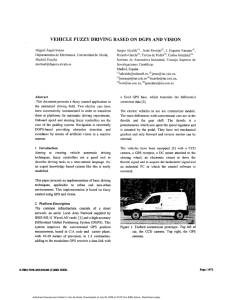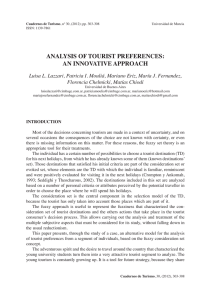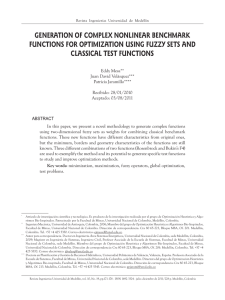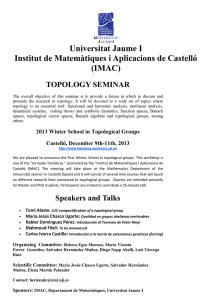article
Anuncio
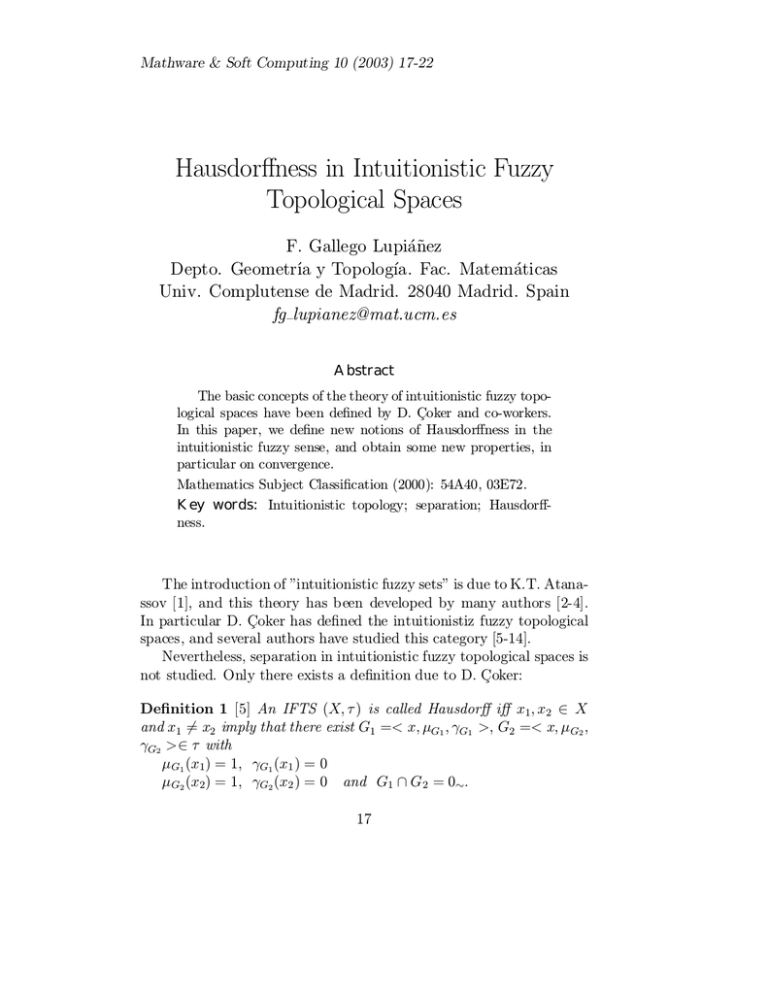
Mathware & Soft Computing 10 (2003) 17-22 Hausdor®ness in Intuitionistic Fuzzy Topological Spaces F. Gallego Lupi¶a ~nez Depto. Geometr¶³a y Topolog¶³a. Fac. Matem¶aticas Univ. Complutense de Madrid. 28040 Madrid. Spain fg lupianez@mat.ucm.es Abstract The basic concepts of the theory of intuitionistic fuzzy topological spaces have been de¯ned by D. C »oker and co-workers. In this paper, we de¯ne new notions of Hausdor®ness in the intuitionistic fuzzy sense, and obtain some new properties, in particular on convergence. Mathematics Subject Classi¯cation (2000): 54A40, 03E72. Key words: Intuitionistic topology; separation; Hausdor®ness. The introduction of "intuitionistic fuzzy sets" is due to K.T. Atanassov [1], and this theory has been developed by many authors [2-4]. In particular D. C » oker has de¯ned the intuitionistiz fuzzy topological spaces, and several authors have studied this category [5-14]. Nevertheless, separation in intuitionistic fuzzy topological spaces is not studied. Only there exists a de¯nition due to D. C » oker: De¯nition 1 [5] An IFTS (X; ¿ ) is called Hausdor® i® x1; x2 2 X and x1 6= x2 imply that there exist G1 =< x; ¹G1 ; °G1 >; G2 =< x; ¹ G2 ; °G2 >2 ¿ with ¹ G1 (x1) = 1; °G1 (x1 ) = 0 ¹ G2 (x2) = 1; °G2 (x2 ) = 0 and G1 \ G 2 = 0». 17 18 F. Gallego Lupi¶an~ez But this de¯nition is not suitable for to characterize net convergence in intuitionistic fuzzy topological spaces. Then, in this paper, we will de¯ne two new kinds of intuitionistic fuzzy topological spaces and obtain various properties. Firstly, we list some previous de¯nitions: De¯nition 2 [7] Let X be a nonempty set and c 2 X a ¯xed element in X. If ® 2 (0; 1] and ¯ 2 [0; 1) are two ¯xed real numbers such that ® + ¯ · 1, then the IFS c(®; ¯) =< x; c® ; 1 ¡ c1¡¯ > is called an intuitionistic fuzzy point (IFP for short) in X: If ¯ 2 [0; 1) is a ¯xed real number, then the IFS c(¯) =< x; 0; 1 ¡ c1¡¯ > is called a vanishing intuitionistic fuzzy point (VIFP for short) in X: De¯nition 3 [7] (a) Let c(®; ¯) be an IFP in X such that ®; ¯ 2 (0; 1) and A =< x; ¹ A; °A > be an IFS in X. c(®; ¯) is said to be properly contained in A (c(®; ¯) 2 A for short) if ® < ¹A(c) and ¯ > °A(c). (b) Let c(¯) be a VIFP in X such that ¯ 2 (0; 1) and A =< x,¹ A; °A > be an IFS in X. c(¯) is said to be properly contained in A (c(¯) 2 A for short) if ¹A(c) = 0 and ¯ > °A(c): De¯nition 4 [7]. Let (X; ¿ ) be an IFTS on X and N be an IFS in X. N is said to be an "¡neighborhood of an IFP c(®; ¯) in X if there exists an IFOS G in X such that c(®; ¯) 2 G µ N: N is said to be an "-neighborhood of a VIFP c(¯) in X if ¹N (c) = 0 and there exists an IFOS G in X such that c(¯) 2 G µ N: De¯nition 5 [13]. Let X be a non-empty set, P the set of all IFPs and VIFPs of X and D a directed set. An intuitionistic fuzzy net is a map s : D ! P. We denote s d = s(d) (for d 2 D), s = (sd )d2D: De¯nition 6 [13] Let (X; ¿ ) be an IFTS and s be an intuitionistic fuzzy net in X. s converges to an IFP (or a VIFP) p in (X; ¿) if for every "¡neighborhood N of p there exists d0 2 D such that sd 2 N for all d ¸ d 0: Hausdor®ness in Intuitionistic Fuzzy Topological Spaces 19 De¯nition 7 [13] Let X be a non-empty set and F a non-empty family of IFSs6= 0». F is an intuitionistic ¯lter in X if a) for all F 1; F2 2 F is F1 \ F2 2 F. b) for all F 2 F and each IFS F 0 such that F µ F 0 is F 0 2 F. De¯nition 8 [13] Let (X; ¿ ) be an IFTS and F be an intuitionistic ¯lter in X. F converges to an IFP p in (X; ¿ ) if every "-neighborhood of p is member of F: Remark. If p = c(®; ¯) is an IFP in an IFTS (X; ¿ ) and M is an IFOS in X such that ¹ M (c) = 1; °M (c) = 0 it does not imply that M is an "-neighborhood of p (let, for example ® = 1; ¯ = 0). This fact motives that the C » oker's de¯nition of Hausdor®ness intuitionistic fuzzy topological spaces is not suitable for to characterize convergence in intuitionistic fuzzy topological spaces. We will introduce some new kinds of Hausdor®ness in intuitionistic fuzzy topological spaces. De¯nition 9 An IFTS (X; ¿ ) will be called T2 if for every p; q IFPs or VIFPs in X such that p 6= q there exists "-neighborhodds M and N of p and q respectively such that M \ N = 0» : Clearly, for c(®; ¯) we discard ® = 1; ¯ = 0, and for c(¯) the case ¯ = 0. Proposition 1. Let (X; ¿ ) be an IFTS. Then (X; ¿ ) is T 2 if and only if every convergent intuitionistic fuzzy net in (X; ¿) has an only limit. Proof. If (sd )d2D converges to p and q, two IFPs or VIFPs such that p 6= q, then for every "-neighborhoods M and N of p and q respectively there are dM ; dN such that sd 2 M for d ¸ dM and sd 2 N for d ¸ dN . Thus for some d0 ¸ dM ; dN is s d 2 M \ N for all d ¸ d0 , and M \ N 6= 0» [13, Proposition 1]. Conversely, if (X; ¿ ) is not T2 there exist two IFPs or VIFPs p and q such that p 6= q and, for all "-neighborhoods M; N of p and q respectively is M \ N 6= 0».Then, there is either an IFP or VIFP s(M;N) 2 M \ N [13, Proposition 1]. Let D = f(M; N)jM "¡neighborhood of p and N "-neighborhood of qg directed by µ. Then the intuitionistic fuzzy net (s(M;N))(M;N)2D converges to p and q: 20 F. Gallego Lupi¶an~ez De¯nition 10 (15) A fuzzy topological space (X; T ) is said to be fuzzy Hausdor® if for any two fuzzy points xr ; ys with distinct supports there exist disjoint ¹; º 2 T with xr 2 ¹ and xs 2 º (In this de¯nition the value of any fuzzy point xr is such that 0 < r < 1). Proposition 2. Let (X; ¿ ) be an IFTS. If (X; ¿) is T2; then (X; ¿1) is a fuzzy Hausdor® fts (where ¿1 = f¹G jG 2 ¿g). Proof. For any two fuzzy points xr ; ys with distinct supports and 0 < r; s < 1, we have that p = x(r; 1 ¡ r), q = y(s; 1 ¡ s) are two distinct IFPs. Then, there exist "-neighborhoods M and N of p and q respectively such that M \ N = 0». This implies that r < ¹M (x); s < ¹N (y) and xr 2 ¹M ; ys 2 ¹N which are fuzzy neighborhoods with ¹M ^ ¹N = ;: Proposition 3. Let (X; ¿ ) be an IFTS: If (X; ¿) is T 2 every convergent intuitionistic ¯lter in (X; ¿) has an only limit. Proof. If F converges to p and q two distinct IFPs, then the intuitionistic fuzzy net associated to F, sF converges to p and q [13, Theorem] and (X,¿) is not T2: (The converse is not true because the convergence of intuitionistic ¯lters is de¯ned only to IFPs). De¯nition 11 An IFTS (X; ¿ ) will be called q¡T2 if for every distinct IFPs or VIFPs p and q in X there exist "¡neighborhoods M and N of 0 p and q respectively such that ¹ M · ¹0N and °M ¸ °N : Proposition 4. Every T2 IFTS is q ¡ T2: Proof. Let p; q be two distinct IFPs nor VIFPs then, there exist "-neighborhoods M; N of p and q respectively such that M \ N = 0» . Since we have that ¹M ^ ¹N = ;; °M _ °N = 1, this implies that 0 ¹M · ¹0N and °M ¸ °N : De¯nition 12 A fuzzy topological space (X; T ) will be called q-fuzzy Haussdor® if for any two fuzzy points xr ; ys with distinct supports there exist ¹,º 2 T with xr 2 ¹; ys 2 º and ¹ · 1 ¡ º. Hausdor®ness in Intuitionistic Fuzzy Topological Spaces 21 (In this de¯nition also the value of any fuzzy point xr is such that 0 < r < 1): Proposition 5. Let (X; ¿ ) be an IFTS. If (X; ¿ ) is q¡T2 then (X; ¿1) is a q¡fuzzy Hausdor® fts. Proof. For any two points xr ; ys with distinct supports and 0 < r; s < 1, we have that p = x(r; 1 ¡ r); q = y(s; 1 ¡ s) are two distinct IFPs. Then, there exist "-neighborhoods M and N of p and q respectively 0 : This implies that x 2 ¹ ; y 2 ¹ such that ¹M · ¹0N and °M ¸ °N r M s N which are fuzzy neighborhoods with ¹M · 1 ¡ ¹N : The author thanks to Professors D. C » oker and S.J. Lee for making available their papers to him. References [1] K.T. Atanassov: Intuitionistic fuzzy sets, in VII ITKR's Session, So¯a (June 1983). [2] K.T. Atanassov: Intuitionistic fuzzy sets, Fuzzy Sets Syst. 20 (1986), 87-96 [3] K.T. Atanassov: Review and new results on intuitionistic fuzzy sets, preprint IM-MFAIS-1-88, So¯a (1988). [4] K.T. Atanassov: Intuitionistic fuzzy sets. Theory and applications, Springer-Verlag (Heidelberg, New York, 1999). [5] D. C » oker: An introduction to intuitionistic fuzzy topological spaces, Fuzzy Sets Syst. 88 (1997), 81-89. [6] D. C » oker: An introduction to fuzzy subspaces in intuitionistic fuzzy topological spaces, J. Fuzzy Math. 4 (1996), 749-764. [7] D. C » oker and M. Demirci: On intuitionistic fuzzy points, Notes IFS 1,2 (1995), 79-84. [8] D. C » oker and A.H. E»s: On fuzzy compactness in intuitionistic fuzzy topological spaces, J. Fuzzy Math. 3 (1995), 899-909. 22 F. Gallego Lupi¶an~ez [9] A.H. E»s and D. C » oker: More on fuzzy compactness in intuitionistic fuzzy topological spaces, Notes IFS 2,1 (1996), 4-10. [10] H. GÄ ur»cay, D. C » oker and A.H. E»s: On fuzzy continuity in intuitionistic fuzzy topological spaces, J. Fuzzy Math. 5 (1997), 365378. [11] N. Turanh and D. C » oker: On some types of fuzzy connectedness in fuzzy topological spaces, Fuzzy Sets Syst. 60 (1993), 97-102. [12] Seok Jong Lee and Eun Pyo Lee: The category of intuitionistic fuzzy topological spaces, Bull. Korean Math. Soc. 37 (2000), 6376. [13] F.G. Lupi¶an~ez: Nets and ¯lters in intuitionistic fuzzy topological spaces, preprint. [14] F.G. Lupi¶a~nez: Covering properties in intuitionistic fuzzy topological spaces, preprint. [15] R. Srivastava, S.N. Lal and A.K. Srivastava: Fuzzy Hausdor® topological spaces, J. Math. Anal. Appl 81 (1981), 497-506.
